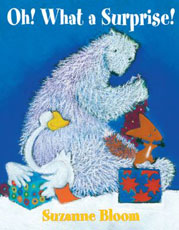Title: Joone
Author/Illustrator: Emily Kate Moon
Publisher: Dial Books
Year: 2013
Word Count: Approx. 325
Summary: Five-year-old Joone, who likes ice cream sandwiches and the colors orange and purple, lives in a yurt with her grandfather and pet turtle, Dr. Chin.
The book Joone is all about Character. So that’s the picture book element I’m going to discuss on the fourteenth and final day of Christie Wright Wild’s PB 14:14 blog challenge. It’s been a lot of fun reading, studying, and sharing fourteen picture books in fourteen days, and I sincerely hope Christie offers the challenge to us again next year.
Now on to the analysis of Joone. Right away, we get to know our title character Joone, who is telling us her story. Look at page one above. It reads, “My name is Joone. Some people spell it with a U. I spell it with a smiley face.” Through the text, we can already tell that Joone has a “happy”, and perhaps precocious, personality. Also, look at the turtle on her head. It’s another clue to her personality. This proves that Character can be shown through illustrations.
Throughout the story, Joone tells us about her life with her grandfather and her pet turtle, Dr. Chin. Her personality is constantly shown through her words and actions.
“Grandpa says it’s important to do things for other people. So, today, I’m organizing his books in rainbow order…”
I love that line and this one:
“Dr. Chin is my turtle. I got him last year when I was little.”
The interaction between Joone and her grandfather is both sweet and humorous:
She taught him how to make a daisy crown to wear on his head.
Sometimes she helps him fix the house. Sometimes she doesn’t.
She’s always busy doing something, to which Grandpa says, “Joone, I don’t know where you find the energy.”
To which Joone replies, “Grandpa, I don’t know either!”
Joone says that if she is good, she gets dessert. And if Grandpa is good, she reads him two bedtime stories.
Character really shines through in this story about a happy little girl and her loving grandfather.






















